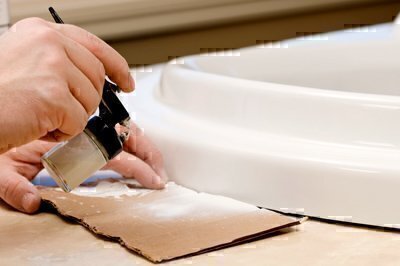Last updated January 2019
Rub-a-dub-dub—eww, is that Victorian-era rust or some unidentifiable stain in your tub? Whether they’re cast iron, steel, or fiberglass, all bathtubs (and the bottoms of composite showers) eventually start to show their age or, sometimes, poor maintenance.
Replacing the thing is always an option. But while tubs themselves are often downright cheap to purchase (drop-in styles can cost under $150), the labor to remove an old model, install a new one, and fix all the tile, moldings, and fixtures in and around it could make the project run hundreds if not thousands of dollars.
 That’s why—especially if you watch a lot of late-night TV—you see those ads for bathtub refinishing or lining. Both processes use your existing tub and cost less than a major tub/bathroom remodel, but they’re quite different. Some are performed by general bath remodeling companies; others by outfits that only spiff up tubs. And while there are do-it-yourself refinishing kits, the contractors and other pros we spoke with insist that these produce a grainy, hand-painted surface that tends to peel after a few months’ use.
That’s why—especially if you watch a lot of late-night TV—you see those ads for bathtub refinishing or lining. Both processes use your existing tub and cost less than a major tub/bathroom remodel, but they’re quite different. Some are performed by general bath remodeling companies; others by outfits that only spiff up tubs. And while there are do-it-yourself refinishing kits, the contractors and other pros we spoke with insist that these produce a grainy, hand-painted surface that tends to peel after a few months’ use.
Refinishing, the cheaper of the two processes (usually $300–$1,000, with claw-foot tubs running the highest), works on cast iron, steel, and fiberglass tubs. It involves stripping the existing model’s enamel with hydrofluoric acid and then applying two coats of epoxy. After this, the tech cleans the tub to remove any dust or dirt, and then sprays on four coats of shiny polyurethane, sanding coats in between. The new old tub must then dry for about a day. And since the chemicals applied are smelly and potentially harmful if inhaled too deeply, the pros will need to tent the area. You might also want to vacate the house for a few hours or for the day after the process. Refinishing can smooth out imperfections, change the color of your tub’s interior (or exterior, but that costs more), and remove discolorations like rust rings. While the resulting surface is a bit more delicate than the original finish (no scrubbing with Brillo or granular cleaners), its surface should look and wear like the tub’s original surface for up to 15 years.
Relining, in essence, coats the existing tub or shower base with a thin, made-to-measure liner formed from a ¼-inch-thick piece of acrylic. This doesn’t work on fiberglass or acrylic tubs, since the liner could damage the material underneath. And freestanding tubs can’t be covered by a liner either.
 For cast iron or steel tubs, a bathtub lining company comes out to take measurements; four to six weeks later, it returns with a factory-made liner that, in theory, is an exact mold of your existing tub. Technicians slip the liner over the tub and its skirt, using an epoxy primer to prep the old tub. The new skin bonds with the old tub, and—if you’ve hired a good company—it shouldn’t leak or detach for up to 20 years. However, relining is a more involved process than refinishing and costs more, usually $1,000–$1,500 for a simple tub.
For cast iron or steel tubs, a bathtub lining company comes out to take measurements; four to six weeks later, it returns with a factory-made liner that, in theory, is an exact mold of your existing tub. Technicians slip the liner over the tub and its skirt, using an epoxy primer to prep the old tub. The new skin bonds with the old tub, and—if you’ve hired a good company—it shouldn’t leak or detach for up to 20 years. However, relining is a more involved process than refinishing and costs more, usually $1,000–$1,500 for a simple tub.
While both methods are generally cheaper than installing a whole new tub, keep in mind that relined tubs tend to look plastic-y. And while in theory they shouldn’t leak, the space between the old tub and its new skin can become mold-infested if a technician doesn’t install the thing properly (or if the liner
doesn’t fit properly). If we were forced to choose between the methods, refinishing would win every time: It simply looks better, and since most tubs can be refinished multiple times, you won’t take a bath financially either.
If you’re thinking of rehabbing your tub, first ask if it’s worth it. If you hate its size or style, or if it’s seriously damaged (holes, structural issues), a makeover might not be worth the cash. But if the thing is in good shape except for the finish, draw up a list of possible pros using the customer reviews we’ve collected. Then call or email several and ask for price quotes. Ask to see before and after photos of finished work, and if they have a showroom you can visit (some outfits do). Get at least three fixed-price bids—and make sure companies know you’re shopping around so they compete for your business.
Once you decide to take the plunge with a bath refinishing pro, get its pricing and guarantees or warranties in writing. Ask how they’ll protect the existing bathroom elements and vent any chemical odors.
Arrange to pay as little as possible until the work is finished and you’re happy with your new soak spot. Then pour in the Mr. Bubble and enjoy!

